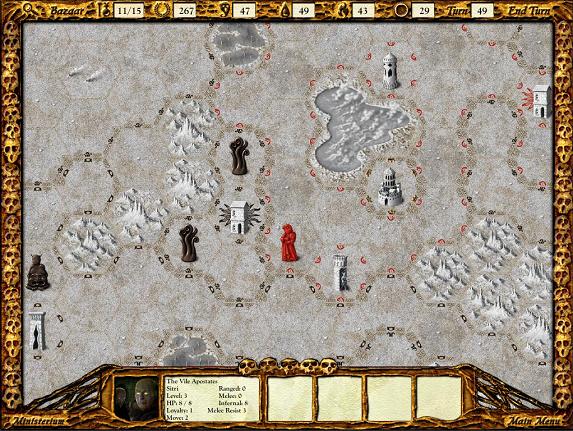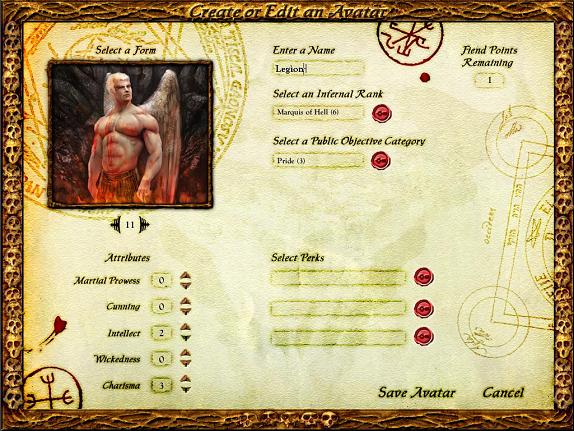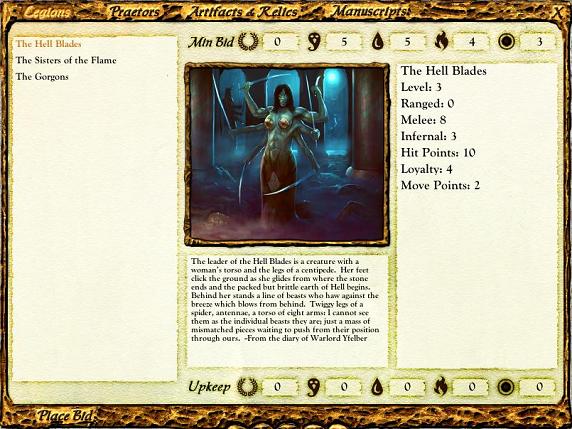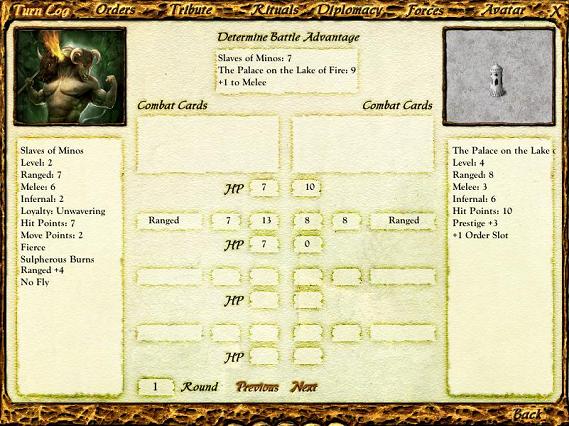
Cryptic Comet’s first game, Armageddon Empires, was an impressive effort, combining CCG-like mechanics with a hex-map based wargame. Not bad for a game made by what is basically a one-man shop, namely QT3 regular Vic Davis. His second game Solium Infernum has been two years in the making and while it’s also a turn-based strategy game played on a hex-map with a design that’s very reminiscent of boardgames, it’s very, very different from the first one.
The most obvious difference is the change in theme. Armageddon Empires was set in a post-apocalyptic world featuring factions inspired by science-fiction. Solium Infernum is set in hell and all the players are archfiends vying against each other for the right to sit on the Infernal Throne left vacant by Lucifer. The most important difference however is that Armageddon Empires was strictly single-player only while Solium Infernum really shines only in multi-player games. You can play it in single-player but the AI currently isn’t smart enough to fully exploit the game’s complex ruleset.
Since there are already a ton of reviews and very well-written game diaries for it, I’m just going to focus on its game mechanics. Note that this is one game that you don’t want to dive into without reading the manual first. I guarantee that you’ll get lost very quickly. First of all, there’s the concept of limited action slots which is common in boardgames but quite rare in video games. Each player typically starts with only two actions per turn. You can get more later in the game by spending resources to boost your archfiend’s attributes eventually getting up to six actions per turn, but you’ll likely have to make do with two actions per turn for quite a while. This is brutal because you need actions to do just about anything. The only exceptions are responding to diplomatic messages and paying upkeep for legions and rituals.
Secondly, resources are completely divorced from territory. In most strategy games, you usually get an amount of resources every turn based on the extent of the territory under your control. Not so in Solium Infernum. Instead, you get resources by using a slot to perform the “Demand Tribute” action, essentially instructing your minions to bring you booty. How bountiful your tribute is depends on your Charisma attribute. You can issue more than one such order per turn but it has diminishing returns. Clearly you almost always want to issue at least one of these orders every turn but because everything else also needs order slots this can be tough. Remember that even moving one of your legions requires an order slot.
Thirdly, you can’t actually produce anything in this game with your resources. Sure, it has legions, which are your fighting units, praetors, which are basically heroes that you can attach to legions to boost them, various magical items and multi-part manuscripts which need to be collected and assembled in order to use, but everything must be bought from a central marketplace called the Bazaar. You do this by submitting a bid for whatever it is that you want using an order slot. Everything has a minimum cost but the item goes to the archfiend who submitted the highest bid, making this a type of auction.
Finally, after you’ve whipped a legion into fighting shape, assigned a tough as nails praetor to lead it, equipped it with an awesome artifact, do you think you can march it directly against the stronghold of a rival archfiend? Actually no, because it turns out that Hell is a very polite place that has strict rules about bureaucracy and etiquette. No archfiend can send any of his legions into the territory of another archfiend unless Pandemonium, basically the capital of Hell, has approved a Vendetta against that archfiend. In fact, in order to attack another player’s stronghold you need a Blood Feud, which is usually possible only after you have prosecuted three Vendettas against that player.
This is where the diplomatic actions come in. You can use an order slot to demand that another archfiend give you some resources, spending some Prestige Points, which is what determines victory at the end of the game, to do so. If the other player concedes to your demand, you get your Prestige wager back plus the resources he gives you. If he refuses, you get to declare a Vendetta against him on your terms. This is because Vendettas aren’t everything goes wars but are highly structured rituals. You can choose to resolve a Vendetta through single combat between praetors or using legions on the battlefield. For the latter, you need to specify an objective, capturing a certain number of enemy hexes, called cantons in the game, destroying some number of enemy legions, or capturing Places of Power within a fixed time limit. Successfully prosecuting a Vendetta earns you Prestige Points while failing to do makes you lose the points you wagered to start it.
Another way to start a Vendetta is by insulting another archfiend. You wager some Prestige Points to do so and the target must either accept the insult, in which case he loses Prestige Points and you gain back your wager plus a bonus reward, or reject the insult but be forced to declare a Vendetta against you, but on terms that he sets. All this means that owning a powerful legion doesn’t automatically allow you to conquer cantons or Places of Power, which since they generate Prestige Points every turn are extremely important. A weaker opponent would be able to keep you at bay for quite a long time simply by giving in to your demands.
Combat is almost entirely non-random. At the legion level, the statistics for the two opposing legions are compared with the difference between the two being inflicted as damage on the weaker unit. Since combat proceeds in phases, the values for Ranged is compared first, then Melee and finally Infernal. If both combatants are still alive after this, another round starts up. Because all these statistics are open information, it is usually quite simple to tell who’s going to win a fight. The exception is that players can attach combat cards to their legions which opposing players can’t see. These cards cost resources to create and are good for only one fight but their power depends on the Martial Prowess of the respective archfiend. Obviously this will upset the results of the battle especially since the effects are very significant at high levels of skill.
Praetor combat is somewhat different as it involves players choosing a sequence of combat moves to perform somewhat like rock-paper-scissors. Different moves impose different costs in terms of orbs, skulls and shields and do different things. Praetors all start with some basic moves available but these are outmatched by the special moves that are be learned by assembling the appropriate manuscripts. It’s important to note that Vendettas that are settled through praetor challenges can’t lead to Blood Feuds.
Anyway, all this is a lot to digest, so I’m stopping here for now. As I’ve mentioned before, the ruleset, especially the multiplicity of diplomatic actions, is too much for the AI so you really need to play against other humans to feel challenged. Unfortunately, a PBEM game will take over a month to complete so I’ve had to wait until after the coming Chinese New Year holidays to get into one. AI aside, the game still has a ton of other problems. For example, there is no in-game documentation at all so constantly alt-tabbing between the game and the PDF manual is a necessity. Even the manual is incomplete in some cases. For example, there is no mention of how many orbs different combat moves cost.
Another problem is that the game still feels like a work in progress as the developer is still improving the AI and fine-tuning the balance on a continuous basis. Currently Charisma is by far the most vital attribute and plenty of perks cost far too much to purchase. Some of the strategic paths, such as Prophecy which allows you to draw and complete Secret Objectives for bonus Prestige Points that are invisible until the end of the game, don’t seem viable compared to simply building an archfiend that focuses entirely on straightforward combat. I expect that I’ll have more to say after I’ve had some experience of the game in PBEM.



Leave a Reply